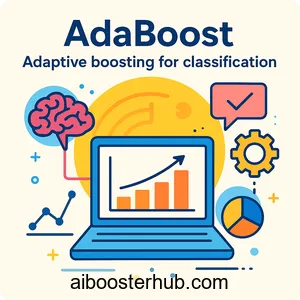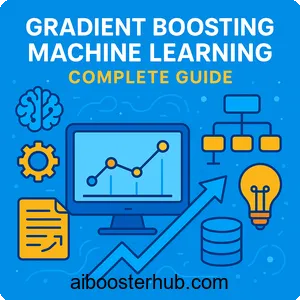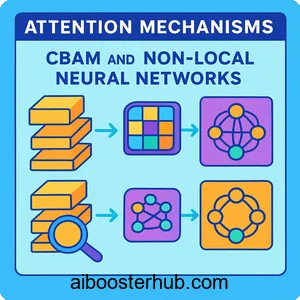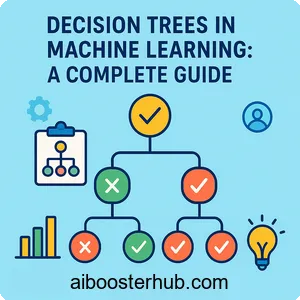AdaBoost: Adaptive boosting for classification
Ensemble learning has revolutionized machine learning by combining multiple models to achieve superior performance. Among the most influential ensemble methods is AdaBoost, short for Adaptive Boosting, which transforms weak learners into powerful classifiers. This boosting algorithm has become a cornerstone technique in classification tasks, offering remarkable accuracy improvements across diverse applications.
AdaBoost stands out in the machine learning landscape by sequentially training classifiers, where each new model focuses on correcting the mistakes of its predecessors. Unlike other ensemble learning approaches that train models independently, the adaptive boosting methodology creates a strong learner by strategically weighting training examples based on classification difficulty. This intelligent adaptation makes the AdaBoost classifier particularly effective for complex decision boundaries.

Content
Toggle1. Understanding the fundamentals of AdaBoost
What makes AdaBoost unique
The AdaBoost algorithm operates on a deceptively simple yet powerful principle: combine multiple weak learners to create a single strong learner. A weak learner is defined as a classifier that performs only slightly better than random guessing, typically with accuracy just above 50% for binary classification problems.
The genius of adaptive boosting lies in its sequential training process. Each iteration focuses on the training examples that previous classifiers misclassified, effectively learning from past mistakes. This adaptive nature distinguishes AdaBoost from traditional ensemble learning methods like bagging, where models train independently on random subsets of data.
The boosting algorithm framework
Boosting algorithms work by maintaining a distribution of weights over the training dataset. Initially, all examples receive equal weight. After training each weak learner, AdaBoost increases the weights of misclassified examples and decreases the weights of correctly classified ones. This weight adjustment ensures that subsequent classifiers pay more attention to difficult examples.
The final AdaBoost classifier combines predictions from all weak learners through weighted voting, where each learner’s vote is proportional to its accuracy. This ensemble approach creates a decision boundary far more sophisticated than any individual weak learner could achieve.
Key components of the algorithm
Three fundamental elements drive the AdaBoost classifier:
Sample weights determine each training example’s importance during model training. Examples that prove difficult to classify accumulate higher weights, forcing future weak learners to prioritize them.
Classifier weights reflect each weak learner’s accuracy. More accurate classifiers receive greater influence in the final ensemble decision, ensuring that reliable models dominate the prediction process.
Error calculation measures each weak learner’s performance on weighted training data. This metric guides both the adjustment of sample weights and the determination of classifier weights.
2. The mathematical foundation of adaptive boosting
Core algorithm mechanics
The AdaBoost algorithm follows a precise mathematical framework. Given a training dataset with \( N \) examples \( {(x_1, y_1), (x_2, y_2), …, (x_N, y_N)} \) where \( y_i \in {-1, +1} \), the process initializes weights uniformly:
$$ w_i^{(1)} = \frac{1}{N}, \quad i = 1, 2, …, N $$
For each iteration \( t = 1, 2, …, T \):
First, train a weak learner \( h_t \) using the current weight distribution \( w^{(t)} \). The weak learner minimizes the weighted error on the training set.
Second, calculate the weighted error rate:
$$ \epsilon_t = \sum_{i=1}^{N} w_i^{(t)} \cdot \mathbb{1}[h_t(x_i) \neq y_i] $$
where \( \mathbb{1}[\cdot] \) is the indicator function that equals 1 when the condition is true.
Determining classifier importance
The algorithm assigns each weak learner a weight based on its accuracy:
$$ \alpha_t = \frac{1}{2} \ln\left(\frac{1 – \epsilon_t}{\epsilon_t}\right) $$
This formula ensures that classifiers with lower error rates receive exponentially higher weights. When \( \epsilon_t \) approaches 0 (perfect classification), \( \alpha_t \) becomes very large. Conversely, when \( \epsilon_t \) approaches 0.5 (random guessing), \( \alpha_t \) approaches 0.
Updating sample weights
After evaluating weak learner \( h_t \), AdaBoost updates the sample weights:
$$ w_i^{(t+1)} = w_i^{(t)} \cdot \exp(-\alpha_t \cdot y_i \cdot h_t(x_i)) $$
This exponential update dramatically increases weights for misclassified examples while reducing weights for correct predictions. The weights are then normalized to form a probability distribution:
$$ w_i^{(t+1)} = \frac{w_i^{(t+1)}}{\sum_{j=1}^{N} w_j^{(t+1)}} $$
Final classification decision
The final strong learner combines all weak learners through weighted voting:
$$ H(x) = \text{sign}\left(\sum_{t=1}^{T} \alpha_t \cdot h_t(x)\right) $$
This aggregation creates a powerful classifier that leverages the collective wisdom of all weak learners, with more accurate models having proportionally greater influence.
3. Implementing AdaBoost in Python
Building a basic AdaBoost classifier
Let’s implement AdaBoost from scratch to understand its inner workings. We’ll create a simple version using decision stumps (single-level decision trees) as weak learners:
import numpy as np
from sklearn.tree import DecisionTreeClassifier
from sklearn.datasets import make_classification
from sklearn.model_selection import train_test_split
from sklearn.metrics import accuracy_score
class SimpleAdaBoost:
def __init__(self, n_estimators=50):
self.n_estimators = n_estimators
self.alphas = []
self.weak_learners = []
def fit(self, X, y):
n_samples = X.shape[0]
# Initialize weights uniformly
weights = np.ones(n_samples) / n_samples
for t in range(self.n_estimators):
# Train weak learner (decision stump)
weak_learner = DecisionTreeClassifier(max_depth=1)
weak_learner.fit(X, y, sample_weight=weights)
# Make predictions
predictions = weak_learner.predict(X)
# Calculate weighted error
incorrect = predictions != y
error = np.sum(weights * incorrect) / np.sum(weights)
# Avoid division by zero or log of zero
error = np.clip(error, 1e-10, 1 - 1e-10)
# Calculate classifier weight
alpha = 0.5 * np.log((1 - error) / error)
# Update sample weights
weights *= np.exp(-alpha * y * predictions)
weights /= np.sum(weights) # Normalize
# Store weak learner and its weight
self.weak_learners.append(weak_learner)
self.alphas.append(alpha)
def predict(self, X):
# Aggregate predictions from all weak learners
weak_predictions = np.array([
alpha * learner.predict(X)
for alpha, learner in zip(self.alphas, self.weak_learners)
])
# Final prediction through weighted voting
return np.sign(np.sum(weak_predictions, axis=0))
# Generate synthetic dataset
X, y = make_classification(n_samples=1000, n_features=20,
n_informative=15, n_redundant=5,
random_state=42)
y = 2 * y - 1 # Convert to {-1, +1}
X_train, X_test, y_train, y_test = train_test_split(
X, y, test_size=0.2, random_state=42
)
# Train and evaluate
adaboost = SimpleAdaBoost(n_estimators=50)
adaboost.fit(X_train, y_train)
y_pred = adaboost.predict(X_test)
accuracy = accuracy_score(y_test, y_pred)
print(f"AdaBoost Accuracy: {accuracy:.4f}")
Using scikit-learn’s AdaBoost implementation
For production applications, scikit-learn provides a robust AdaBoost classifier with additional features:
from sklearn.ensemble import AdaBoostClassifier
from sklearn.tree import DecisionTreeClassifier
from sklearn.datasets import load_breast_cancer
from sklearn.model_selection import cross_val_score
import matplotlib.pyplot as plt
# Load real-world dataset
data = load_breast_cancer()
X, y = data.data, data.target
# Create AdaBoost classifier with decision trees
base_estimator = DecisionTreeClassifier(max_depth=1)
ada_clf = AdaBoostClassifier(
estimator=base_estimator,
n_estimators=100,
learning_rate=1.0,
algorithm='SAMME',
random_state=42
)
# Evaluate using cross-validation
cv_scores = cross_val_score(ada_clf, X, y, cv=5, scoring='accuracy')
print(f"Cross-validation accuracy: {cv_scores.mean():.4f} (+/- {cv_scores.std():.4f})")
# Train on full dataset
ada_clf.fit(X, y)
# Analyze feature importance
feature_importance = ada_clf.feature_importances_
sorted_idx = np.argsort(feature_importance)[::-1][:10]
print("\nTop 10 Most Important Features:")
for idx in sorted_idx:
print(f"{data.feature_names[idx]}: {feature_importance[idx]:.4f}")
Comparing AdaBoost with other ensemble methods
Let’s compare AdaBoost with gradient boosting and other ensemble learning techniques:
from sklearn.ensemble import AdaBoostClassifier, GradientBoostingClassifier, RandomForestClassifier
from sklearn.metrics import classification_report
import time
# Prepare models
models = {
'AdaBoost': AdaBoostClassifier(n_estimators=100, random_state=42),
'Gradient Boosting': GradientBoostingClassifier(n_estimators=100, random_state=42),
'Random Forest': RandomForestClassifier(n_estimators=100, random_state=42)
}
# Compare performance
for name, model in models.items():
start_time = time.time()
model.fit(X_train, y_train)
training_time = time.time() - start_time
y_pred = model.predict(X_test)
accuracy = accuracy_score(y_test, y_pred)
print(f"\n{name}:")
print(f"Accuracy: {accuracy:.4f}")
print(f"Training Time: {training_time:.2f} seconds")
4. Practical applications and use cases
Face detection and computer vision
AdaBoost gained widespread recognition through the Viola-Jones face detection framework, which revolutionized real-time object detection. The algorithm trains cascaded classifiers using simple Haar-like features, achieving remarkable speed and accuracy for face detection in images.
In this application, AdaBoost combines thousands of weak classifiers operating on rectangular features. The boosting algorithm selects the most discriminative features while maintaining computational efficiency. Each stage in the cascade rejects obvious non-face regions quickly, allowing subsequent stages to focus computational resources on promising candidates.
Medical diagnosis systems
Healthcare applications leverage the AdaBoost classifier for disease prediction and diagnosis. Consider a diabetes prediction system:
from sklearn.ensemble import AdaBoostClassifier
from sklearn.preprocessing import StandardScaler
import pandas as pd
# Load medical dataset (example structure)
# Features: glucose level, BMI, age, blood pressure, etc.
medical_data = pd.DataFrame({
'glucose': [148, 85, 183, 89, 137],
'bmi': [33.6, 26.6, 23.3, 28.1, 43.1],
'age': [50, 31, 32, 21, 33],
'blood_pressure': [72, 66, 64, 66, 40],
'diabetes': [1, 0, 1, 0, 1]
})
X = medical_data.drop('diabetes', axis=1)
y = medical_data['diabetes']
# Standardize features
scaler = StandardScaler()
X_scaled = scaler.fit_transform(X)
# Train AdaBoost for medical diagnosis
medical_classifier = AdaBoostClassifier(
n_estimators=200,
learning_rate=0.8,
random_state=42
)
medical_classifier.fit(X_scaled, y)
# Predict for new patient
new_patient = [[120, 30.5, 45, 70]]
new_patient_scaled = scaler.transform(new_patient)
prediction = medical_classifier.predict(new_patient_scaled)
probability = medical_classifier.predict_proba(new_patient_scaled)
print(f"Diabetes Risk: {probability[0][1]:.2%}")
The adaptive boosting approach proves particularly valuable in medical contexts where certain diagnostic indicators may be subtle or easily overlooked. By progressively focusing on difficult cases, AdaBoost identifies complex patterns that single classifiers might miss.
Text classification and sentiment analysis
Natural language processing tasks benefit significantly from ensemble learning methods. AdaBoost excels at text classification by combining multiple feature-based weak learners:
from sklearn.feature_extraction.text import TfidfVectorizer
from sklearn.ensemble import AdaBoostClassifier
from sklearn.tree import DecisionTreeClassifier
# Example text classification
texts = [
"This product is absolutely amazing, highly recommend",
"Terrible quality, waste of money",
"Good value for the price, satisfied with purchase",
"Disappointing experience, would not buy again"
]
labels = [1, 0, 1, 0] # 1 = positive, 0 = negative
# Convert text to features
vectorizer = TfidfVectorizer(max_features=100)
X_text = vectorizer.fit_transform(texts)
# Train AdaBoost for sentiment analysis
sentiment_classifier = AdaBoostClassifier(
estimator=DecisionTreeClassifier(max_depth=2),
n_estimators=50,
random_state=42
)
sentiment_classifier.fit(X_text, labels)
Financial fraud detection
Banking institutions employ AdaBoost classifiers to identify fraudulent transactions by learning patterns from historical data. The algorithm’s ability to focus on minority class examples (fraudulent transactions) makes it particularly suited for imbalanced datasets common in fraud detection.
5. Advantages and limitations
Key strengths of AdaBoost
The adaptive boosting methodology offers several compelling advantages that have maintained its relevance in machine learning:
Simplicity and interpretability: AdaBoost requires minimal parameter tuning compared to modern deep learning approaches. The algorithm’s sequential nature and focus on misclassified examples provide intuitive understanding of the learning process.
Resistance to overfitting: Unlike many machine learning algorithms, AdaBoost demonstrates remarkable resistance to overfitting, particularly when using simple weak learners. The ensemble approach and adaptive weight adjustment create a natural regularization effect.
Versatility with weak learners: The boosting algorithm works effectively with various base classifiers. Decision stumps, shallow decision trees, or even naive classifiers can serve as weak learners, providing flexibility in implementation.
Automatic feature selection: Through its iterative process, AdaBoost implicitly performs feature selection by assigning importance to discriminative features. This characteristic proves valuable for high-dimensional datasets where feature relevance varies significantly.
Challenges and considerations
Despite its strengths, the AdaBoost classifier faces certain limitations:
Sensitivity to noisy data: The algorithm’s focus on misclassified examples can be problematic with noisy datasets. Outliers and mislabeled data receive increasingly high weights, potentially degrading overall performance. Unlike gradient boosting methods that use loss functions to moderate this effect, AdaBoost may struggle with significant label noise.
Sequential training requirement: The adaptive nature of AdaBoost prevents parallel training of weak learners. Each classifier depends on the performance of previous ones, limiting scalability on distributed computing platforms. This sequential constraint becomes more pronounced with large datasets or numerous weak learners.
Computational considerations: While individual weak learners are simple, training hundreds of sequential classifiers can be computationally expensive. The algorithm must repeatedly evaluate all training examples with updated weights, which scales linearly with dataset size and number of estimators.
Hyperparameter sensitivity: The number of weak learners and learning rate significantly impact performance. Too few estimators underfit the data, while excessive estimators may overfit despite AdaBoost’s general resistance. Finding the optimal configuration often requires extensive experimentation.
Comparison with gradient boosting
Gradient boosting has emerged as a powerful alternative to AdaBoost, offering enhanced flexibility through differentiable loss functions. While AdaBoost uses exponential loss and sample reweighting, gradient boosting fits new models to residual errors using gradient descent.
Modern implementations like XGBoost and LightGBM have gained popularity due to advanced regularization techniques, handling of missing values, and efficient parallel processing. However, AdaBoost remains valuable for its simplicity, theoretical guarantees, and effectiveness on clean, structured datasets where interpretability matters.
6. Optimizing AdaBoost performance
Hyperparameter tuning strategies
Maximizing AdaBoost classifier performance requires careful attention to key hyperparameters:
from sklearn.model_selection import GridSearchCV
from sklearn.ensemble import AdaBoostClassifier
from sklearn.tree import DecisionTreeClassifier
# Define parameter grid
param_grid = {
'n_estimators': [50, 100, 200, 300],
'learning_rate': [0.01, 0.1, 0.5, 1.0],
'estimator__max_depth': [1, 2, 3, 4],
'estimator__min_samples_split': [2, 5, 10]
}
# Create base estimator
base_estimator = DecisionTreeClassifier()
# Initialize AdaBoost with base estimator
ada_clf = AdaBoostClassifier(
estimator=base_estimator,
algorithm='SAMME.R',
random_state=42
)
# Perform grid search
grid_search = GridSearchCV(
ada_clf,
param_grid,
cv=5,
scoring='accuracy',
n_jobs=-1,
verbose=1
)
grid_search.fit(X_train, y_train)
print("Best Parameters:", grid_search.best_params_)
print("Best Cross-Validation Score:", grid_search.best_score_)
# Evaluate on test set
best_model = grid_search.best_estimator_
test_accuracy = best_model.score(X_test, y_test)
print(f"Test Accuracy: {test_accuracy:.4f}")
Handling imbalanced datasets
Class imbalance presents challenges for ensemble learning methods. AdaBoost can be adapted using several strategies:
from sklearn.utils.class_weight import compute_sample_weight
from imblearn.ensemble import BalancedBaggingClassifier
# Strategy 1: Use sample weights
sample_weights = compute_sample_weight('balanced', y_train)
ada_balanced = AdaBoostClassifier(n_estimators=100, random_state=42)
ada_balanced.fit(X_train, y_train, sample_weight=sample_weights)
# Strategy 2: SMOTE with AdaBoost
from imblearn.over_sampling import SMOTE
from imblearn.pipeline import Pipeline as ImbPipeline
smote = SMOTE(random_state=42)
ada_smote = ImbPipeline([
('smote', smote),
('classifier', AdaBoostClassifier(n_estimators=100, random_state=42))
])
ada_smote.fit(X_train, y_train)
Early stopping and model complexity
Preventing overfitting while maintaining strong performance requires monitoring validation metrics:
from sklearn.model_selection import learning_curve
import numpy as np
import matplotlib.pyplot as plt
def plot_learning_curve(estimator, X, y):
train_sizes, train_scores, val_scores = learning_curve(
estimator, X, y, cv=5,
train_sizes=np.linspace(0.1, 1.0, 10),
scoring='accuracy',
n_jobs=-1
)
train_mean = np.mean(train_scores, axis=1)
train_std = np.std(train_scores, axis=1)
val_mean = np.mean(val_scores, axis=1)
val_std = np.std(val_scores, axis=1)
plt.figure(figsize=(10, 6))
plt.plot(train_sizes, train_mean, label='Training Score')
plt.plot(train_sizes, val_mean, label='Validation Score')
plt.fill_between(train_sizes, train_mean - train_std,
train_mean + train_std, alpha=0.1)
plt.fill_between(train_sizes, val_mean - val_std,
val_mean + val_std, alpha=0.1)
plt.xlabel('Training Examples')
plt.ylabel('Accuracy')
plt.title('Learning Curve for AdaBoost')
plt.legend()
plt.grid(True)
plt.show()
# Visualize learning behavior
ada_clf = AdaBoostClassifier(n_estimators=100, random_state=42)
plot_learning_curve(ada_clf, X, y)
Feature engineering for AdaBoost
Proper feature preparation enhances the boosting algorithm’s effectiveness:
from sklearn.preprocessing import StandardScaler, PolynomialFeatures
from sklearn.pipeline import Pipeline
# Create preprocessing and modeling pipeline
pipeline = Pipeline([
('scaler', StandardScaler()),
('poly_features', PolynomialFeatures(degree=2, include_bias=False)),
('classifier', AdaBoostClassifier(
n_estimators=100,
learning_rate=0.8,
random_state=42
))
])
# Train pipeline
pipeline.fit(X_train, y_train)
# Evaluate
y_pred = pipeline.predict(X_test)
print(f"Pipeline Accuracy: {accuracy_score(y_test, y_pred):.4f}")
7. Conclusion
AdaBoost represents a foundational breakthrough in ensemble learning and machine learning, demonstrating how strategic combination of weak learners creates powerful classification systems. The adaptive boosting methodology’s elegant mathematical framework, combined with practical effectiveness across diverse applications, has established it as an essential technique in the data scientist’s toolkit. From face detection systems to medical diagnosis and fraud prevention, the AdaBoost classifier continues to deliver reliable performance where accuracy and interpretability matter.
While modern alternatives like gradient boosting and deep learning have emerged, AdaBoost maintains relevance through its simplicity, theoretical guarantees, and resistance to overfitting. Understanding this boosting algorithm provides crucial insights into ensemble methods and serves as a stepping stone to more advanced techniques. Whether you’re building production systems or exploring machine learning fundamentals, AdaBoost offers a powerful approach to transforming weak learners into robust, high-performing strong learners that solve real-world classification challenges.









